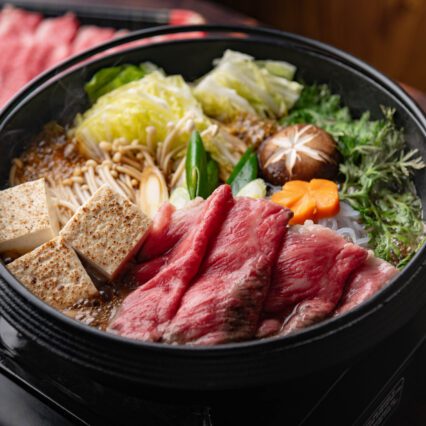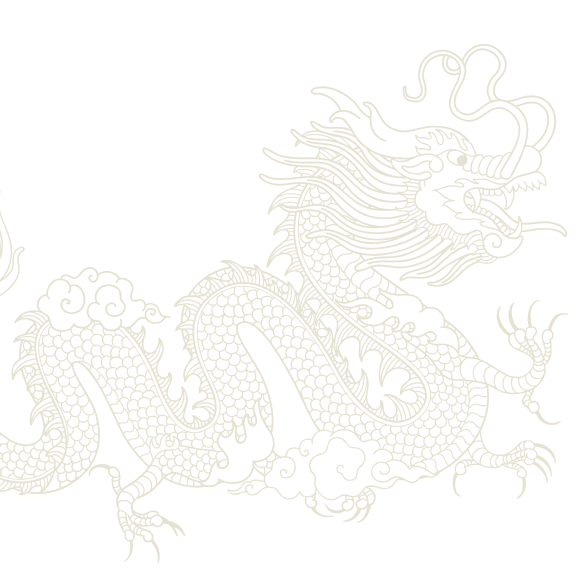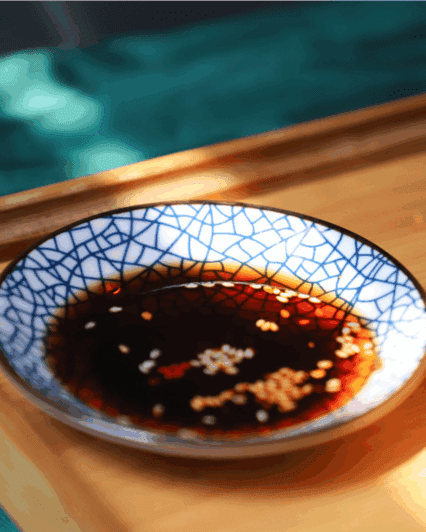What is Sukiyaki?

What is Sukiyaki?
Let’s get to it:
For the Uninitiated, an Intro to Sukiyaki
A basic description of sukiyaki is thin beef slices briefly seared — hence the “yaki” in the name — before simmering in warishita or sukiyaki sauce. Warishita is made up of soy sauce, mirin, sake, sugar, and dashi sauce (sometimes, more on that in a bit). Alongside the thin sliced beef, other ingredients are simmered in the sauce including tofu, green onions, various kinds of mushrooms, chrysanthemum greens, shirataki noodles, and Chinese cabbage. It’s generally eaten communally, with diners picking ingredients straight out of the pan and dipping into a bowl of beaten raw egg before eating.
Other meats or seitan — that’s concentrated wheat protein, essentially delicious pure gluten — are sometimes used instead of beef, too.
Sukiyaki, along with shabu shabu, are recent additions to the repertoire of Japanese cuisine due to the aforementioned restrictions on eating most meats which lasted from the 600 until the mid-1800s.
These two dishes are sometimes confused because they’re quite similar and involve thinly-sliced beef, much of the same accompanying ingredients, and a quick simmer — the main difference between sukiyaki and shabu shabu is in the flavor profile of the sauce and a couple key differences in the cooking itself.
Unlike sukiyaki, shabu shabu doesn’t cook in such a concentrated sauce, but rather in either simmering water or dashi with kelp and served with ponzu (citrus-based) or goma (sesame-based) dipping sauces.
It also isn’t seared like sukiyaki and instead is briefly swished in the boiling broth (the name shabu shabu is an onomatopoeia for the “swish” of the beef). Because there’s not a rich sauce to impart flavor onto the beef, shabu shabu beef is cooked in mere moments, while sukiyaki beef — although still being cooked just briefly to keep the flavor fresh — is simmered longer.
Sukiyaki has a more complex, sweeter flavor due to the sweet soy-based broth, while in shabu shabu the natural taste of the beef and vegetables shine with the more delicate broth. This becomes particularly noticeable as the broth gets seasoned over the course of the meal from the beef and vegetables being dipped in it.
A Quick Note on the Two Main Sukiyaki Styles and the Process for Each
Sukiyaki tends to fall under two types: Kansai-style or and Kanto-style, which can also be referred to as Osaka-style and Tokyo-style.
This mostly comes down to a difference in the warishita; in Kanto-style sukiyaki, the sauce is diluted with dashi and the beef does most of its cooking by simmering in this sauce (even though some will sear it a bit too).
In Kansai sukiyaki, the beef is always seared, during which time sugar is sprinkled on it. Then it’s doused in soy sauce and sake to simmer with the vegetables and other ingredients. Because there’s no dashi to dilute the warishita, the sauce flavor becomes far more concentrated and the dish overall is less “soupy.” The dryer, more concentrated dish plus more steps means Kansai-style also takes greater skill and precision because there are higher chances of error, and less leeway for those mistakes to go unnoticed in the final taste and texture.
Sukiyaki is really one of the most craveable foods on the whole planet. It’s succulent, meaty and rich, sweet and full of umami. There are very few ways to enjoy beef that are more flavorful (and fun) than sukiyaki and shabu shabu. Both dishes are filled with a variety of good and delicious vegetables and endless possibilities to explore. At Uwajimaya, you’ll find all the ingredients you need to enjoy sukiyaki at home including warishita sauces, vegetables and our very own sukiyaki beef skillfully sliced by our butchers.




